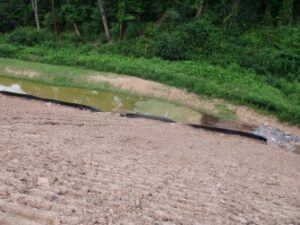Stream and Wetland Delineation
Wetlands are areas that are inundated or saturated by surface or ground water at a frequency and duration sufficient to support, and that under normal circumstances do support, a prevalence of vegetation typically adapted for life in saturated soil conditions. Wetlands generally include swamps, marshes, bogs, and similar areas. To be a wetland, an area only needs to be saturated for a portion of the growing season, so wetlands do not always have standing water or even saturated soil present. Wetlands are the transitional land between terrestrial and aquatic systems where the water is near the surface. They are not only beautiful and provide recreation, they are important for maintaining wildlife diversity, filtering nutrients, and for flood control. Although they comprise a small percentage of the nation’s total land area, they have a disproportionately higher number of unique plants and animals.

West Virginia isn’t wildly known for our wetlands, but the Mountain State is home to over 102,000 acres of wetlands! Canaan Valley, Dolly Sods Wilderness Area, Pleasant Creek Wildlife Management Area, and Green Bottom Wildlife Management Area are just a few places to view wetlands in WV. Cranberry Glades Botanical area is home to a high-altitude cluster of boreal-type peat bogs found rarely outside of Canada. You can also spot two native carnivorous plants – the purple pitcher and sundew. Practice social distancing by taking a hike and seeing if you can spot a WV Wetland near you! The WVDEP has published a wonderful guide to wetland plant identification in the Mountain State that can be downloaded at:

Triad understands that good project planning includes identifying existing resources early in project planning. Our biologists know that a good delineation report not only maps the location and extent of streams and wetlands in your project area, but also determines which features are regulated by the state and federal government. We areexperienced in planning to avoid impacts and permitting unavoidable impacts to aquatic habitats. Our environmental team is able to complete site specific wetland restoration and mitigation plans. For questions or assistance on Stream & Wetland Delineations or Clean Water Section 404/401 permitting and mitigation, please contact our Senior Scientist Carol Phillips at cphillips@triadeng.com.
For more information about Triad Engineering and the services we offer, visit the what we do section of our website.


